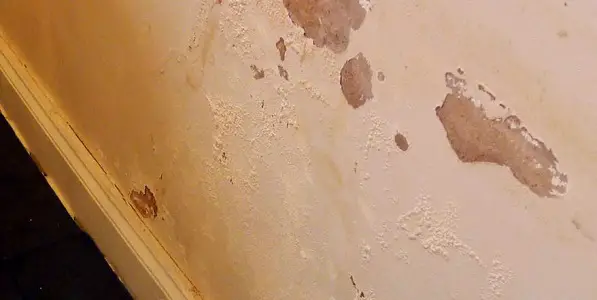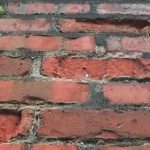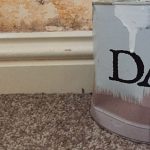The DIY Fix is reader supported. When you buy after clicking a link on our site, we may earn an affiliate commission.
All damp in the home is a problem. However, not all types of damp are equal. Different types require different forms of treatment. To this end, it’s important that you identify the type of damp that you have in the home from the outset. This means you will be able to select the most appropriate and effective course of treatment and remedial action.
This leads us to the key question: Can you get rising damp upstairs? Strictly speaking, it is very unlikely for rising damp to rise beyond 1 metre above ground level. This essentially means that if you have damp upstairs, it almost certainly isn’t rising damp. However, there are various reasons why other types of damps can appear in the upstairs of a property. These types of damp are penetrating damp and condensation damp.

The problem with identifying rising damp
One of the problematic things about rising damp, and the correct identification of damp, is that it often looks the same.
To the untrained eye, the tell-tale signs of damp look very much the same. And, just to make matters more confusing, every property is different. There are several symptoms of rising damp. However, it’s not uncommon for only one of those symptoms to be in evidence.
So, the likes of wallpaper coming unstuck or paint that doesn’t seem to stick to the surface of the walls are both giveaways that you have a rising damp problem. Similarly, if you notice stains to the bottom of a wall, or stains that look like ‘tidemarks’, then rising damp is likely to be the issue.
Other signs are if plaster is flaking or if a whiteish powder appears on walls. Finally, any visible damp patches or signs of crumbling mortar to the building’s exterior, often points to rising damp being the issue too.
However, many of these symptoms are identical to, or very similar, to the signs of other types of damp. Remember, there could always be more than one type of damp affecting a property. All forms of damp require an accurate and careful diagnosis.
So, let’s deal with the likely causes of damp that are usually found upstairs.
Upstairs Damp: Penetrating damp
Penetrating damp, as the name suggests, is caused by water leaking through and penetrating walls. It can be quite destructive, expanding across the surface it penetrates. However, there is a key distinction between penetrating damp and rising damp. Penetrating damp comes through a surface (such as a wall); whereas rising damp travels upwards.
Penetrating damp is usually caused by structural problems to a building. Common issues include a crack in a wall, or faulty guttering or roofing. The latter two explain why penetrating damp is often first noticed in the upstairs rooms in a property. Essentially, over time water penetrates the walls when they are soaked by heavy rainfall. Older properties tend to be more susceptible to penetrating damp, as newer buildings with cavity walls provide more protection.
However, penetrating damp can also be caused by internal leaks. For example, leaking pipes can also cause penetrating damp.
The obvious signs of penetrating damp are damp patches on a wall or ceiling. Often the patch will appear to darken after periods of heavy rainfall. Any discolouration, mould or blistering often indicates penetrating damp.
How to deal with penetrating damp
Gaps between window frames and doors can cause penetrating damp. Therefore, it is important to ensure that the property is airtight. Deal with any broken parts: frames, gutters, and pipes promptly. Often, fixing any cracks that appear will be enough to solve the damp problem.
Old bricks can sometimes become porous. If this happens, the bricks should be replaced. An easier option – worth trying first – is to apply a sealant to the wall. Damp-proof exterior paint can also be useful. Another potential cause of penetrating damp can be if a cavity wall has been compromised. This often occurs where there is a natural break in the wall, such as pipes or a window. A cavity tray is the usual solution.
The common problem of condensation damp
Condensation is the most common kind of damp found in domestic properties. It is caused when moist warm air condenses on cool walls. It is particularly common in rooms that generate a lot of natural moisture.
In the home, the two rooms that do this the most are the kitchen and the bathroom. This explains why condensation is often discovered to be an issue upstairs. Condensation is also mainly, although not exclusively, a problem in the winter months. This is because the walls of a property can be colder than the air inside.
Similarly, condensation can be more of a problem when you are using the central heating. Warm and damp air is formed when the heating gets warm and then cools. The problem of condensation is exacerbated if a property is poorly ventilated.
It also tends to be more of an issue in older properties. It used to be standard practice with house design to allow properties to naturally ‘breathe.’ Another common concern is when double glazing is installed in older properties. This can reduce ventilation further still and make condensation worse.
The signs of condensation are easy to spot. Droplets of water form on walls and windows. Dark mould is often seen, and this often comes with a very unpleasant accompanying smell.
The longer this mould is left untreated, the more damage it can cause to paint, plaster and window frames. So, when you see it, you should wipe it away with a cloth. Dehumidifiers are a useful way to reduce the amount of moisture in the air.
Steps to deal with condensation
The easiest way to reduce problems with condensation is to improve ventilation around the home, but particularly in affected areas. This can really be as simple as remembering to open windows for a time when you are at home.
More permanent solutions include building air bricks into outside walls and installing air vents through internal walls. Another option is to add a window vent to the top of a window frame. There is a balance to be struck here and an element of compromise, as ventilation measures will inevitably mean that some heat is lost from the house.
The two rooms in the home that will always be responsible for the greatest amount of moisture are best served by having extractor fans. For the kitchen and bathroom, installing extractor fans if you don’t have them is a very worthwhile investment. This will reduce the amount of moisture in the home significantly, improve ventilation, and greatly lessen the chances of condensation becoming a problem.
Other tips include improving the insulation in the home, such as adding cavity wall and loft insulation. It’s also better for air temperature and the prevention of damp to have heating on a consistent low level, rather than swinging to and from extremes. If you don’t have an extractor fan, you should open windows when cooking or showering. Drying clothes outside on a line rather than inside on a radiator is another way to limit condensation.
Dealing with upstairs damp
So, in conclusion, it’s very likely that if you damp upstairs in a property, it is unlikely to be rising damp. It is far more likely to penetrating damp or condensation. Of course, it is possible that all three main types of damp are present in a property. The most important thing is that you don’t just apply a blanket approach to treatment.
You need to accurately diagnose the type and likely cause of damp and treat each case precisely and accurately.




